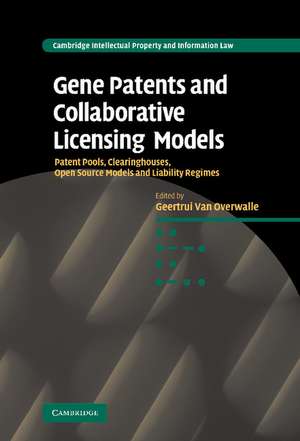Gene Patents and Collaborative Licensing Models: Patent Pools, Clearinghouses, Open Source Models and Liability Regimes: Cambridge Intellectual Property and Information Law, cartea 10
Editat de Geertrui van Overwalleen Limba Engleză Hardback – 10 iun 2009
Din seria Cambridge Intellectual Property and Information Law
- 9%
 Preț: 695.66 lei
Preț: 695.66 lei -
 Preț: 206.82 lei
Preț: 206.82 lei -
 Preț: 285.16 lei
Preț: 285.16 lei - 9%
 Preț: 766.15 lei
Preț: 766.15 lei - 14%
 Preț: 726.42 lei
Preț: 726.42 lei -
 Preț: 185.40 lei
Preț: 185.40 lei - 14%
 Preț: 788.63 lei
Preț: 788.63 lei -
 Preț: 286.30 lei
Preț: 286.30 lei - 23%
 Preț: 853.98 lei
Preț: 853.98 lei -
 Preț: 335.34 lei
Preț: 335.34 lei -
 Preț: 445.69 lei
Preț: 445.69 lei - 14%
 Preț: 784.48 lei
Preț: 784.48 lei - 14%
 Preț: 900.65 lei
Preț: 900.65 lei - 11%
 Preț: 500.96 lei
Preț: 500.96 lei -
 Preț: 320.55 lei
Preț: 320.55 lei - 11%
 Preț: 457.05 lei
Preț: 457.05 lei -
 Preț: 322.51 lei
Preț: 322.51 lei -
 Preț: 320.55 lei
Preț: 320.55 lei -
 Preț: 321.31 lei
Preț: 321.31 lei -
 Preț: 285.75 lei
Preț: 285.75 lei - 14%
 Preț: 728.05 lei
Preț: 728.05 lei - 14%
 Preț: 900.65 lei
Preț: 900.65 lei - 14%
 Preț: 895.68 lei
Preț: 895.68 lei - 14%
 Preț: 727.26 lei
Preț: 727.26 lei -
 Preț: 283.63 lei
Preț: 283.63 lei - 14%
 Preț: 729.73 lei
Preț: 729.73 lei - 14%
 Preț: 776.59 lei
Preț: 776.59 lei - 11%
 Preț: 520.41 lei
Preț: 520.41 lei -
 Preț: 396.20 lei
Preț: 396.20 lei - 14%
 Preț: 755.35 lei
Preț: 755.35 lei - 14%
 Preț: 725.43 lei
Preț: 725.43 lei -
 Preț: 322.51 lei
Preț: 322.51 lei - 14%
 Preț: 1008.85 lei
Preț: 1008.85 lei -
 Preț: 470.76 lei
Preț: 470.76 lei -
 Preț: 288.04 lei
Preț: 288.04 lei
Preț: 901.48 lei
Preț vechi: 1048.23 lei
-14% Nou
Puncte Express: 1352
Preț estimativ în valută:
172.49€ • 180.58$ • 142.73£
172.49€ • 180.58$ • 142.73£
Carte tipărită la comandă
Livrare economică 05-19 aprilie
Preluare comenzi: 021 569.72.76
Specificații
ISBN-13: 9780521896733
ISBN-10: 0521896738
Pagini: 516
Dimensiuni: 155 x 235 x 27 mm
Greutate: 0.93 kg
Editura: Cambridge University Press
Colecția Cambridge University Press
Seria Cambridge Intellectual Property and Information Law
Locul publicării:Cambridge, United Kingdom
ISBN-10: 0521896738
Pagini: 516
Dimensiuni: 155 x 235 x 27 mm
Greutate: 0.93 kg
Editura: Cambridge University Press
Colecția Cambridge University Press
Seria Cambridge Intellectual Property and Information Law
Locul publicării:Cambridge, United Kingdom
Cuprins
Part I. Patent Pools: 1. Patent pooling for gene-based diagnostic testing: conceptual framework Birgit Verbeure; 2. Case 1. The MPEG LA® licensing model. What problem does it solve in biopharma and genetics? Lawrence A. Horn; 3. Case 2. IP fragmentation and patent pools: the SARS case Carmen E. Correa; 4. Critical analysis of patent pools Jorge A. Goldstein; Part II. Clearing Houses: 5. Clearinghouse mechanisms in genetic diagnostics: conceptual framework Esther van Zimmeren; 6. Case 3. The global biodiversity information facility. An example of an information clearinghouse James L. Edwards; 7. Case 4. BirchBob: an example of a technology exchange clearing house Esther van Zimmeren and Dirk Avau; 8. Case 5. The public intellectual property resource for agriculture. A standard license public sector clearinghouse for agricultural IP Alan B. Bennett and Sara Boettiger; 9. Case 6. The science commons material transfer agreement project. A standard license clearing house? Thinh Nguyen; 10. Case 7. The collective management of copyright and neighbouring rights. An example of a royalty collection clearing house Jan Corbet; 11. Comment on the conceptual framework for a clearing house mechanism Michael Spence; Part III. Open Source: 12. Open source genetics: a conceptual framework Janet Hope; 13. Case 8. CAMBIA's biological open source initiative (BiOS) Nele Berthels; 14. Case 9. Diversity Arrays Technology Pty Ltd.: applying the open source philosophy in agriculture Andrzej Kilian; 15. Critical commentary on 'open source' in the life sciences Arti K. Rai; 16. Several kinds of 'should': the ethics of open source in life sciences innovation Antony Taubman; Part IV. Liability Regimes: 17. Pathways across the valley of death: novel intellectual property strategies for accelerated drug discovery Arti K. Rai, Jerome H. Reichman, Paul F. Uhlir and Colin Crossman; 18. Case 10. The international treaty on plant genetic resources for food and agriculture: the standard material transfer agreement as implementation of a limited compensatory liability regime Victoria Henson-Apollonio; 19. Critical analysis of property rules, liability rules and molecular futures: bargaining in the shadow of the cathedral Dan L. Burk; Part V. Different Perspectives: 20. Gene patents: from discovery to invention. A geneticist's view Gert Matthijs and Gert-Jan Van Ommen; 21. 'Patent Tsunami' in the field of genetic diagnostics. A patent practitioner's view Jacques Warcoin; 22. Gene patents and clearing models. Some comments from a competition law perspective Hanns Ullrich; 23. Access to genetic patents and clearinghouse model. An economic perspective Reiko Aoki; 24. The role of law, institutions and governance in facilitating access to the scientific research commons. A philosopher's perspective Tom Dedeurwaerdere; Part VI. Concluding Thoughts: 25. Of thickets, blocks and gaps: designing tools to resolve obstacles in the gene patents landscape Geertrui van Overwalle.
Recenzii
"Van Overwalle has done an excellent job in creating a compilation that offers diverse perspectives on the feasibility and desirability of translating successful licensing schemes from other industries (electronics, software, entertainment) to biotechnology."
-J. Jonas Anderson,The IP Law Book Review
-J. Jonas Anderson,The IP Law Book Review
Descriere
An examination of legal measures which might be used to solve the problem of fragmentation of patents in genetics.













